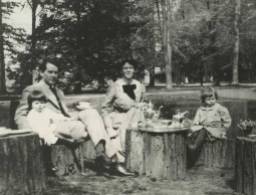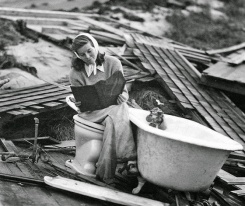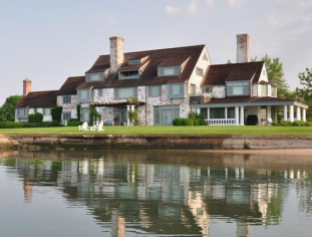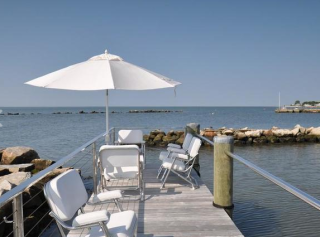
“Isn’t it funny? Hartford is always two places to me: what it was then and what it is now.” –Katharine Hepburn
Sharp-witted and sophisticated, Katharine Hepburn was a pivotal figure in Golden Age cinema. Her independent life and strong-willed movie characters cemented her as a role model for multiple generations of women. She maintained a distinct physical presence, boasted the exaggerated vowels of a well-bred New Englander in her often-imitated voice, and possessed a face defined by remarkably high cheekbones. Among her many achievements, she was a four-time Academy Award winner, and also popularized trousers for women. Despite her various accomplishments, and her reputation as a Hollywood icon, the opening line of her last will and testament read, simply, “I am Katharine Hepburn of Fenwick, Connecticut.”
While Hepburn identified herself as Fenwick resident, her time in Connecticut actually began in Hartford, where she was born. Katharine Houghton Hepburn was born into a tight-knit family, whose contented social status and unconventional opinions nurtured her self-confidence and individuality. Her mother was a suffrage and birth control activist, and her father was a urologist who sought to educate the public about the prevention of sexually transmitted diseases. The Hepburns encouraged Katharine to sharpen her mind, speak her thoughts, and engage with the world as fully as possible.
Young Hepburn was a tomboy, and liked to call herself Jimmy. She cut her hair short, and enjoyed swimming, running, diving, riding, wrestling, and playing golf and tennis. Katharine took golf lessons each day. She loved swimming, and took ice-cold baths every morning, believing that “the bitterer the medicine, the better it is for you.” Hepburn was a fan of films from a young age, and tried to see one each Saturday night. She would orchestrate plays with her friends and siblings, and perform for neighbors at the price of fifty cents per ticket, in order to raise money for the Navajo people.
Although the Hepburn family generally maintained a happy life, tragedy struck in 1921 with the death of her brother, Tom. While visiting in New York, the Katharine found Tom hanging from the attic rafters. The circumstances surrounding his death remain unclear. On one hand, Tom may have been experiencing his family’s history of depression, but on the other, there is the belief that he was trying to attempt a magic trick that he had heard about from his father. Eventually, Katharine came to the conclusion that he had taken his own life.
Regardless of the circumstances, Katharine was crushed by the death of her brother. They had often played athletic games together when growing up, and generally protected one another. After Tom’s death, Katharine became very withdrawn and depressed, leading to poor performance in school. Soon after, Katharine left high school and never returned. With Tom’s absence, Katharine seemed to fulfill the roll of both daughter and son, trying to take his place within the family, as a means of coping. She even took on Tom’s birthday, November 8th, as her own, though she was indeed born on May 12th.
Katharine was tutored at home until she went to university in Bryn Mawr in 1924. However, she found university life difficult and was often depressed. She was almost dismissed due to poor academic performance, until she decided to become an actress. This meant that she would have to improve her grades, in order to participate in the student productions. Once her marks had improved, she performed the lead role in a production of The Woman in the Moon during her senior year. The positive response to her performance further convinced Hepburn to pursue an acting career. She graduated with a degree in history and philosophy in June of 1928.
Hepburn’s initial attempts to break into acting were not very successful. Upon graduating, she attempted to get a role in a Baltimore stock theatre company. Although her performance was well received, she was criticized for having a shrill voice, and left Baltimore to study with a voice tutor in New York City. In her next attempt at a show, she turned up late, mixed up her lines, tripped over her feet, and spoke too quickly to be comprehensible. She was immediately fired. She was briefly married to Ludlow Ogden Smith, with plans to leave the theatre behind, but missed her work and returned to attempting to secure a part on the stage. After joining a theatre company in Massachusetts, she received the criticism of “She looks a fright, her manner is objectionable, and she has no talent.” Afterwards, she landed a spot in a Connecticut stock company, alongside Leslie Howard. Unfortunately, she was dismissed because she “wasn’t very good.”
Eventually, Katharine’s breakout performance occurred with the Broadway run of The Warrior’s Husband. She perfectly exhibited the aggressive energy and athleticism that the role required. A scout for a Hollywood agent was in the crowd during Hepburn’s performance, and asked her to test for a part in the melodrama, A Bill of Divorcement. George Cukor thought of her as an “odd creature […] unlike anybody.” He particularly liked the way she picked up a glass during the screen test. He offered her the role, and encouraged the studio to accept her demands. At 25 years old, Hepburn starred alongside John Barrymore with no sign of intimidation.
Katharine appeared in a myriad of films afterwards, namely Stage Door and Bringing Up Baby. Despite being cast in films with talented costars, her performances did not resonate well with audiences and critics. Following this decline in her career, Hepburn took action to create her own comeback vehicle. She left Hollywood to look for a stage project, and signed on to star in Philip Barry’s new play, The Philadelphia Story. It was tailored to showcase the actress, with the character of socialite Tracy Lord incorporating a mixture of humor, aggression, nervousness, and vulnerability. Howard Hughes, Hepburn’s partner at the time, sensed that the play could be her ticket back to Hollywood stardom and bought her the film rights before it even debuted on stage. The Philadelphia Story first toured the United States, to positive reviews, and then opened in New York at the Schubert Theatre on March 29, 1939. It was a big hit, critically and financially, running for 417 performances and then going on a second successful tour.
Several of the major film studios approached Hepburn to produce the film version of Barry’s play. She chose to sell the rights to Metro-Goldwyn-Mayer (MGM), Hollywood’s number one studio, on the condition that she be the star. As part of the deal she also received the director of her choice, George Cukor, but the costars she wanted, Clark Gable and Spencer Tracy, were both unavailable. Louis B. Mayer promised her James Stewart and $150,000 “for anyone else you want or can get.” Hepburn chose her friend and previous costar, Cary Grant, to whom she ceded top billing.
Before filming began, Hepburn shrewdly noted, “I don’t want to make a grand entrance in this picture. Moviegoers … think I’m too la-di-da or something. A lot of people want to see me fall flat on my face.” Thus the film began with Grant knocking the actress flat on her backside. Berg describes how the character was crafted to have audiences “laugh at her enough that they would ultimately sympathize with her”, which Hepburn felt was crucial in “recreating” her public image.
The Philadelphia Story was one of the biggest hits of 1940, breaking records at Radio City Music Hall.The review in Time declared, “Come on back, Katie, all is forgiven.”
In between Stage Door and Bringing Up Baby, Katharine’s fondness for her family home in Fenwick continued to grow. While the Hepburn family initially maintained a residence in Hartford, Katharine’s birthplace, and then moved into a new home in Hartford, their estate in Fenwick was especially dear to Katharine. Fenwick, a tiny borough, is where the Hepburn family would summer for almost a century. Hepburn would return to Fenwick time and again to plot comebacks, escape on the weekends, or retreat to during old age. She contended, “The me I know is the person at Fenwick.”
In 1938, a hurricane devastated the beloved Hepburn estate in Fenwick. As the story goes, Katharine Hepburn was out playing golf in Fenwick as the monster storm was approaching. Hepburn and many others rode out the storm in Fenwick. There was no radar, satellite, or buoys. Nobody had any idea about what was about to roar ashore. Many experts today believe it would be likened to what we now know as a category 4 Hurricane. Nearly 700 died in the storm. Along coastal New England 9,000 homes were destroyed, including the Hepburn home in Fenwick.
As far as the Hepburn home in Connecticut, the only fixture that survived was the bath tub. So vast was Katharine’s love of Fenwick, that she would rebuild the home within one year. She raised it several feet to try and keep any more storms at bay and stronger, out of brick, not wood. Nearly 60 years later, that brick has held up just fine.
Hepburn enjoyed a successful career in films, but developed a someone cold and withdrawn reputation. She would avoid or offer rude comments to the press, and dismiss autograph requests. However, this attitude thawed over the years as she got older and became increasingly more open with the public. Despite a zeal for privacy, she did enjoy fame, and began to respond to the many fan letters and autograph requests that persisted well into her later years.
Hepburn spent years flying from coast to coast or abroad, as her career demanded. Yet, she always came back to Fenwick and Old Saybrook. It was a haven for her, a retreat, a place she called “paradise” and it was to this paradise that she retired in 1997, sixty-five years after her screen debut. Fittingly, she would also die there, in 2003.
Today, echoes of Hepburn’s life in Connecticut are still evident in both Hartford and Fenwick.
The Hepburn family’s first home was at 22 Hudson Street, just across the street from the Hartford Hospital. The house on Hudson Street has been demolished and taken over by the hospital. As Katharine put it, “The street no longer exists. The hospital grew over it.”
The Hepburn family then moved to 133 Hawthorne Street. It was in this residence that Hepburn’s mother worked on most of her campaigning. Margaret Sanger, the founder of Planned Parenthood, occasionally stopped by the home for tea. The 133 Hawthorne Street home no longer exists.
The final Hartford residence for the Hepburn family was actually in West Hartford, at 201 Bloomfield Street, opposite the University of Hartford. It was in this home that Katharine married her first and only husband. Upon her father’s death, Hepburn donated the home to the neighboring University, which uses it to this day.
Katharine’s Fenwick home still stands in the borough of Fenwick and has been completely remodeled by a New York Developer. Saybrook was her love and she was well known in the town. While the interior has been redone, the exterior remains in the way that Katharine had rebuilt it.
Katharine was well loved in her community, while living in her Fenwick home during her later years. If you’d like to follow in her footsteps, I do know that she used to shop at Walt’s Food Market.
The Katharine Hepburn Cultural Arts Center is also in town, holding exhibits about its namesake.
Upon Hepburn’s death, the town of Hartford hosted a play in honor of Kate, entitled Tea at Five.
When Tom Hepburn died in 1921, the family took a piece of his favorite climbing rock from Fenwick, and engraved his name on the stone in the family plot. Katharine and Tom are now buried beside each other in the Cedar Hill Cemetery in Hartford.
For more than 60 years, Hepburn maintained a residence in New York City’s Turtle Bay neighborhood at 244 E. 49th Street. One year after her passing, the four-story brownstone was sold sight-unseen to a fan for $3.9 million. Turtle Bay houses a Katharine Hepburn Garden in Hepburn’s honor.
As I write this article, the Katharine Hepburn Cultural Arts Center is holding a birthday event for Katharine. If you find yourself in Connecticut, chances are you will also find traces of Kate the Great!

This post was published as a contribution to The Great Katharine Hepburn Blogathon.

































































Wonderful – that home looks so much like her – beautiful, classic, practical and sturdy. My family lives near Old Saybrook and it was always know as the town where Katharine Hepburn lived.
Agreed. Fit for a queen!
Pingback: The Great Katharine Hepburn Blogathon 2016 is upon us! - Margaret Perry
Fantastic! Wonderful article.
Pingback: Spencer Tracy | Hometowns to Hollywood
Pingback: Classic Movie Travels: Spencer Tracy and Milwaukee Wisconsin | Classic Movie Hub Blog
Pingback: Eve Arden | Hometowns to Hollywood
Pingback: Robert Young | Hometowns to Hollywood
Pingback: Billie Burke | Hometowns to Hollywood
Pingback: June Haver | Hometowns to Hollywood
Pingback: Humphrey Bogart | Hometowns to Hollywood
Pingback: Hollywood Kitchen | Hometowns to Hollywood
Pingback: Katharine Hepburn’s Brownies | Hometowns to Hollywood
Pingback: What Price Hollywood? | Hometowns to Hollywood
Pingback: Strictly Dynamite | Hometowns to Hollywood